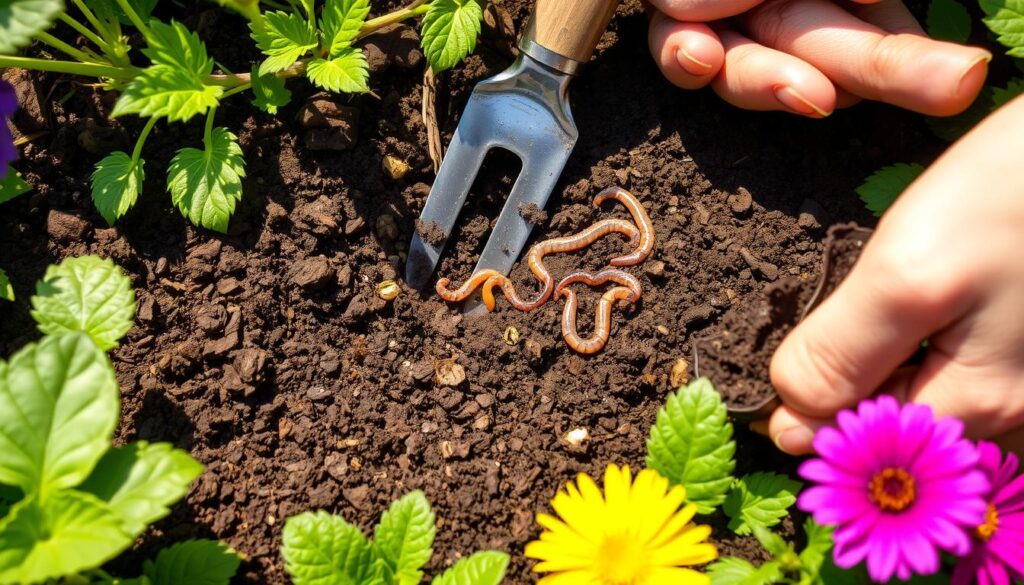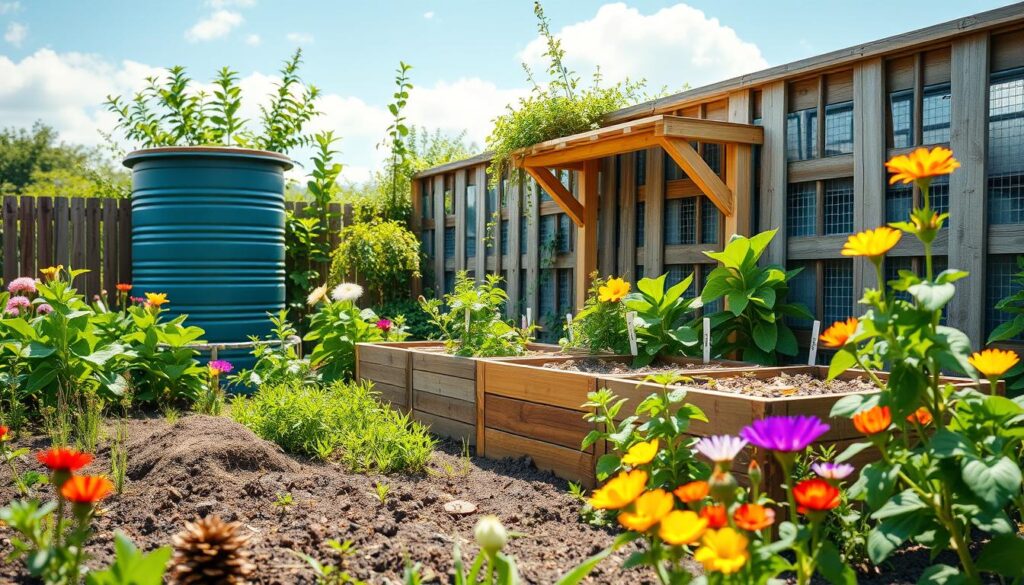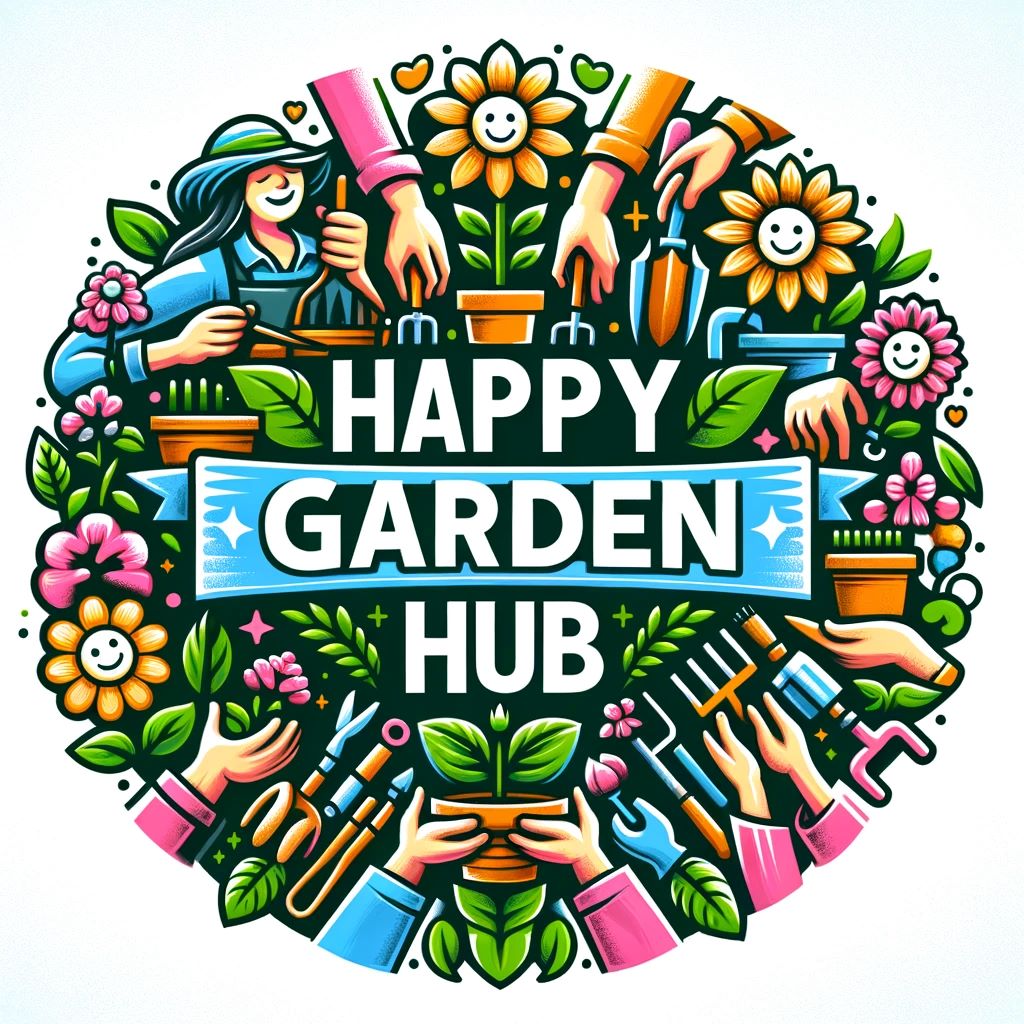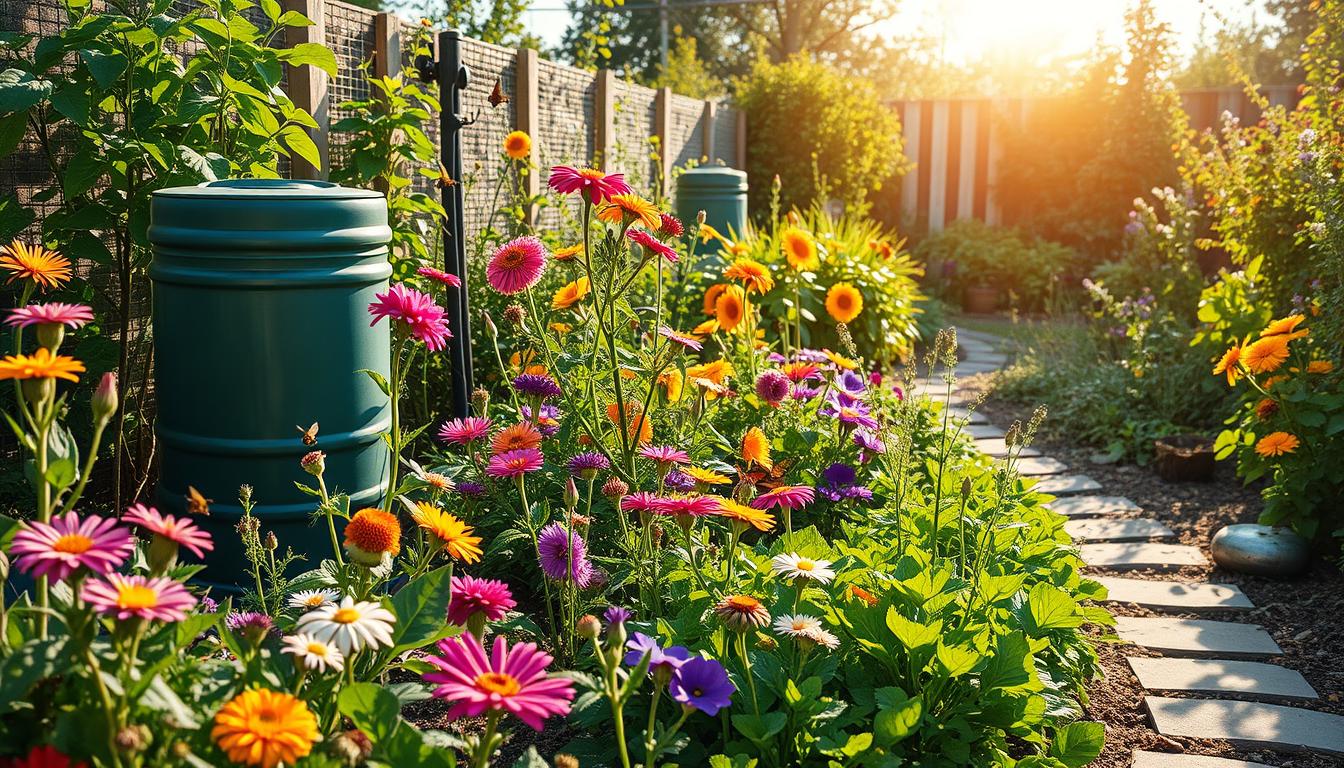This post contains affiliate links.
Imagine walking into your garden and feeling a deep sense of peace. The flowers sway in the breeze, and you know you’re helping the planet. Water-wise gardening is all about creating beautiful spaces that also save water. It’s a way to care for our planet and enjoy our gardens at the same time.
Today, we need to take care of our environment more than ever. By using water-saving methods and choosing plants that don’t need much water, you can make your yard beautiful and eco-friendly. This way, you can enjoy your garden while also helping the planet.
Our gardens can live in harmony with nature. As droughts and water shortages become more common, using sustainable gardening helps us use less water. Whether you’re updating a small area or a big yard, water-wise gardening has practical tips. These tips help your garden grow strong and protect local wildlife. For more ideas, check out the Happy Garden Hub for your gardening journey.
Key Takeaways
- Water-wise gardening conserves precious water resources while promoting beautiful landscapes.
- Drought-tolerant plants are central to creating sustainable and attractive gardens.
- Embracing eco-friendly gardening practices benefits local ecosystems and biodiversity.
- Transforming landscapes with water-efficient methods can significantly reduce lawn maintenance costs.
- Utilizing resources like local gardening guides enhances your understanding of regional planting needs.
Introduction to Eco-Friendly Yards
Creating eco-friendly yards means making homes greener. It uses environmental sustainability in landscaping. This includes native plants and smart water use, fitting each area’s climate and ecosystem, like Florida’s.
Many places have lost a lot of open space and wildlife homes. In Illinois, less than 0.01% of the native prairie is left from the 1800s. This loss leads to big environmental problems, showing we need to use eco-friendly ways.
Native plants are key for biodiversity. They grow well in local conditions and help create important areas like prairies and wetlands. These plants support local wildlife, like birds and butterflies, which are often threatened by invasive species.
Water saving is a big part of eco-friendly yards. About 30 percent of a home’s water goes to the lawn. Using rain barrels to collect water helps save it. Rain gardens also help with water, making it cleaner and healthier for ecosystems.
These steps help us take care of our planet. They make us feel connected to our community. Eco-friendly yards show our dedication to a greener future for all.
Understanding Water-Wise Gardening
Water-wise gardening is all about using less water to keep your garden healthy. It’s about picking plants that need less water and can handle the local weather. This way, you save water and help your garden grow strong.
What is Water-Wise Gardening?
Water-wise gardening means choosing plants that are native and can handle drought. It also means using smart irrigation like soaker hoses. These hoses can save up to 90% of water compared to old sprinklers.
By doing this, you can cut down on how much water your garden uses. In the summer, gardens can use over half of a home’s water. But with the right planning, your garden can still look great with very little water.
Benefits of Water-Wise Gardening
Choosing water-wise gardening saves a lot of water. You’ll use less water and spend less on upkeep. For example, using organic mulch can cut down a plant’s water needs by half.
Healthy plants need less water, fertilizer, and pest control. This helps your garden and the environment around it. It’s good for local wildlife and makes your garden healthier.
As you make your garden more water-efficient, group plants by their water needs. Collecting rainwater is also a great way to save water. Just one inch of rain on a 1,000 square foot roof can give you about 625 gallons of water.
By following these tips, you save money and help the environment. It’s a win-win for both your wallet and the planet.
For more tips on water-wise gardening, check out these resources.
Xeriscaping: The Core Principle of Water Conservation
Xeriscaping is a new way to landscape that saves water. It started in the Southwest and helps make outdoor spaces beautiful while saving water. By using xeriscape design, homeowners can use less water, which is great for places like Utah.
Origin and Definition of Xeriscaping
Xeriscaping comes from the Greek word “xeros,” meaning dry. It focuses on using plants that don’t need much water and smart irrigation. This is very important in Utah, one of the driest states.
Key Components of Xeriscape Design
Good xeriscape design has a few key parts:
- Thorough Planning: Know the landscape’s needs to save water.
- Soil Analysis: Check the soil’s pH in Utah to help plants grow.
- Water-Efficient Plants: Pick plants that need little water.
- Efficient Irrigation Systems: Use systems like drip irrigation to save water.
- Mulching: Mulch helps keep the soil moist and saves water.
- Hydrozoning: Group plants by their water needs.
- Maintenance: Keep plants and soil healthy to save water.
This approach makes outdoor spaces beautiful and helps save water. It lets plants that like dry conditions grow well. For more on this, check out National Gardening Day to see how gardening is good for us and the planet.
Choosing Drought-Tolerant Plants
Adding drought-tolerant plants to your garden is key for climate-resilient gardening. These plants do well in dry and low-water areas, needing less water. They save water and help the environment by supporting local ecosystems.
Top Drought-Tolerant Plant Options
- Sapphire Mist Aster – Thrives in Zones 3 to 8
- Black-Eyed Susan – Suitable for Zones 3-9
- Arizona Apricot Blanket Flower – Grows in Zones 3-10
- Blue Whiskers Blue Fescue – Recommended for Zones 4-8
- Cransebill Geranium – Adaptable in Zones 3-9
- Luscious Golden Gate Lantana – Best in Zones 9-11
- Sweet Romance Lavender – Grows well in Zones 5-9
- Mojave Red Purslane – Thrives in Zones 10-11
- Fruit Punch ‘Classic Coral’ Pinks – Suitable for Zones 3-9
- Lakota Fire Coneflower – Flourishes in Zones 3-9
Importance of Native Plants in Water-Wise Gardening
Native plants are a big plus for water-wise gardening. They are made for local conditions and need less water than others. They also fight off pests and diseases better and help local wildlife.
Choosing native plants makes your garden a lively ecosystem. It helps keep nature in balance and supports many species.
Efficient Irrigation Practices
Using water wisely is key for a sustainable garden. Smart watering helps save water and keeps plants healthy. This way, you can have a lush garden without wasting resources.
Implementing Smart Irrigation Systems
Modern irrigation tech makes a big difference. A well-set drip system cuts down on water waste. It saves time and money too.
For big trees, you might need up to 12 emitters. Small trees or new ones need 3 to 5. Make sure drip tubing doesn’t go over 200 feet from the valve. Micro-tubing should stay under 6 feet for best water flow.
“Smart” irrigation controllers adjust watering based on weather. Rain sensors stop watering when it rains. Soil moisture sensors can also adjust schedules if the soil is already moist.
Timing and Techniques for Watering
When you water matters a lot. Watering in the early morning or late evening cuts down on evaporation. This ensures plants get the moisture they need.
Multi-stream rotor nozzles water evenly and are good for lawns. Traditional sprinklers can use a lot of water, so setting them right is key. Drip systems, on the other hand, are much more efficient, watering 1 to 4 gallons per hour directly into the soil.
Soaker hoses and bubblers also save water, delivering about 2 gallons per minute. Using these methods not only saves water but also helps plants grow well. It also means you use less municipal water.
Soil Analysis: Foundation of a Sustainable Garden
Understanding soil composition is key to successful gardening. Soil analysis is the first step to achieving optimal soil health. This directly affects the potential for a nutrient-rich garden. Knowing how to garden wisely with water helps both plants and the environment.
The Importance of Soil Health
Healthy soil is essential for a thriving garden. It provides nutrients and holds water well. This means less need for harmful chemicals and more efficient gardening.
Keeping the right soil pH is crucial. It makes sure plants can absorb nutrients, helping them grow well.
Conducting a Soil Test for Optimal Plant Selection
A detailed soil analysis helps choose the right plants and gardening methods. It looks at nutrients like nitrogen and potassium. This way, gardeners pick plants that fit their soil best.
Services like the King Conservation District offer free soil tests. This makes getting important data easier for everyone.
| Soil Type | Characteristics | Best Plants |
|---|---|---|
| Clay-rich | Retains moisture, prone to compaction | Native shrubs, perennials |
| Sandy | Poor in organic material, drains quickly | Succulents, drought-tolerant plants |
| Loamy | Balanced moisture and nutrients | Vegetables, herbs, flowering plants |
With the right soil analysis and knowledge, gardeners can create lush, sustainable gardens. These gardens follow water-wise practices.

Mulching: The Unsung Hero of Water Conservation
Mulching is key in water-wise gardening. It boosts plant health and saves water. Using materials like shredded bark or compost, it creates a layer that helps the garden and saves water.
Benefits of Organic Mulch
Organic mulch has many benefits. It makes the soil healthier over time, adding nutrients and helping microbes. It also keeps the soil temperature right, cool in summer and warm in winter. A 2-3 inch layer is best for these benefits.
- Rich in nutrients that support plant growth.
- Aids in soil moisture retention, reducing irrigation frequency.
- Blocks sunlight, effectively suppressing weed growth.
- Decreases soil erosion by up to 60% during heavy rains.
- Encourages biodiversity by nurturing microorganisms.
How Mulch Helps Retain Soil Moisture
Mulch acts as a protective layer, reducing evaporation by up to 70%. This means plants use water better, saving water and money. It also keeps soil temperatures stable, helping roots grow well.
Mulch around vegetable gardens keeps moisture in and soil temperatures steady. This gives plants the best chance to grow. Remember to replace organic mulch yearly and avoid it being too thick to prevent pests. Mulching is essential for eco-friendly gardening, combining beauty with water saving.
Utilizing Rain Gardens in Your Landscape
Rain gardens are great for stormwater management and make your garden look better. They help keep water clean by filtering it naturally. This stops pollutants from getting into local waterways.
By using rain gardens, you can reduce erosion. Rainwater soaks into the soil instead of running off. This helps keep groundwater levels up and prevents flooding.
Place rain gardens at least 10 feet from buildings and 15 feet from septic systems. Choose plants that love moisture, like azaleas and California gray rush, for your garden.
When setting up a rain garden, dig a wide, shallow hole. Use rocks to edge it. This makes your garden look good and work well.
Joining programs like “Lawn Be Gone” can help pay for rain gardens. Homeowners in San Mateo County get rebates to help with costs.
Rain gardens are a smart choice for a green, beautiful garden. For more gardening tips, check out essential flower gardening tips.
Minimizing Lawn Areas for Better Water Use
Creating a landscape with less lawn helps save water. Traditional lawns need a lot of water and upkeep. By choosing better options, you can make your outdoor area lively and water-friendly.
Alternatives to Traditional Grass Lawns
There are many eco-friendly lawn substitutes. Native grasses need half the water of regular lawns after they grow. Ground covers like thyme, kurapia, and dymondia use up to 60% less water. They add beauty and color to your garden.
Creating Attractive Ground Covers and Plant Beds
Designing eco-friendly garden beds is exciting. Use plants like yarrow, verbena, chamomile, and ajuga reptans. They do well in different water zones, based on light, soil, and care.
Adding decorative stones and patios can make your garden look great. Use smart watering systems like drip irrigation and soaker hoses. They fit your garden’s shape for the best water use.
Practicing Proper Fertilization for Eco-Friendly Gardening
Responsible fertilization is key to keeping plants healthy and gardens productive. It’s important to know how fertilizers help plants grow and protect the environment. Eco-friendly fertilization helps gardeners choose the right nutrients for their plants.
Understanding the Role of Fertilizers
Fertilizers give plants the nutrients they need to grow, like nitrogen, phosphorus, and potassium. Organic fertilizers make soil healthier and plants stronger. They also help achieve sustainable gardening goals. Choose slow-release fertilizers to manage nutrients better and prevent water pollution.
When and How to Fertilize Responsibly
Timing and how you apply fertilizers are crucial. Early spring is the best time to fertilize. This lets plants use the nutrients all season long. Here are some tips:
- Do a soil test to see what nutrients your plants need.
- Use compost made from fruit scraps and grass clippings for nitrogen.
- Use mulch like hay or leaves to keep the soil moist.
- Use drip irrigation to water plants directly and save water.
By following these eco-friendly fertilization tips, you can make your plants healthier and protect local waterways. For more tips on sustainable gardening, check out resources from trusted organizations here.

| Fertilization Strategy | Benefits |
|---|---|
| Soil Testing | Identifies nutrient deficiencies for tailored fertilizer use. |
| Organic Options | Supports soil health and reduces chemical runoff. |
| Slow-Release Fertilizers | Provides a steady supply of nutrients while minimizing leaching. |
| Composting | Enhances soil structure and stimulates beneficial microbial activity. |
Attracting Wildlife to Your Eco-Friendly Yard
Creating an eco-friendly yard is more than making it look good. It’s about making a home for wildlife. This helps keep the garden healthy and balanced. By welcoming different species, like mammals, birds, and insects, your garden becomes a thriving ecosystem.
Benefits of Biodiversity in Your Garden
Adding many types of plants to your yard makes it better for the environment. It shows that gardens are for all living things, not just people. Using natural ways to keep pests away and recycling garden waste helps the ecosystem. It also gives food to local wildlife.
Planting for Pollinators and Beneficial Wildlife
Planting plants that attract bees and butterflies is a great idea. These plants are good for the environment and need less care. Make sure to add places for animals to drink and hide, too. This makes your garden a safe haven for wildlife.
Using native plants and sustainable resources helps make your garden a wildlife sanctuary. This is especially important because many natural areas are disappearing. Trees and shrubs provide homes for animals, helping them thrive.
For more ideas on making your garden better for wildlife, check out essential gardening practices. They can help you attract more diverse wildlife.
Water Conservation Tips for Every Gardener
Every gardener can make a big difference by saving water. Smart watering and using new gardening tech are key. Here are some tips to help you save water.
Simple Actions to Reduce Water Usage
Small changes can make a big impact on water use. Here are some effective tips:
- Use rain barrels to catch roof runoff for your plants.
- Apply mulch (2-3 inches) to reduce soil evaporation.
- Water deeply but less often; every two to three days is enough, even in summer.
- Choose plants like Lavender or Black-Eyed Susan that need little water once grown.
Implementing Technology for Better Water Management
Technology can help save water in your garden. Here are some ways to use it:
- Install drip irrigation systems to water roots directly, cutting down on waste.
- Try soaker hoses for slow, steady moisture, keeping soil damp.
- Use smart irrigation controls that adjust based on weather or soil moisture.
By following these tips, you can improve water use in your garden. This will also make your garden healthier and more resilient.
Conclusion
Water-wise gardening is key to sustainable landscaping and eco-friendly practices. Techniques like xeriscaping and using drought-tolerant plants save water. Efficient irrigation systems, like drip irrigation, also help.
Mulching stops weeds and saves water. Composting and cover cropping make soil healthy and moist. By checking soil moisture, gardeners can use water wisely.
Water-wise gardening helps not just gardens but the whole ecosystem. It makes gardens look better, saves money, and protects water. These actions lead to a greener future for our planet.
FAQ
What is water-wise gardening?
How can I make my yard more eco-friendly?
What are the benefits of using native plants in my garden?
How can I improve my irrigation efficiency?
What is xeriscaping, and how can I start?
Why is soil analysis important for water-wise gardening?
How does mulching contribute to water conservation?
What are rain gardens, and how can they benefit my property?
What should I consider when selecting alternatives to traditional lawns?
How can I fertilize responsibly in my garden?
How can I encourage wildlife in my eco-friendly garden?
What are some simple tips for conserving water in my garden?
This post contains affiliate links.

